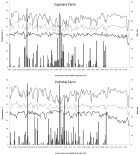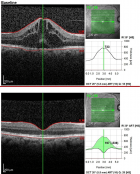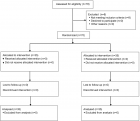Abstract
Research Article
Silicon rates and beneficial microorganism on blast suppression and productivity of upland rice
Alan Carlos Alves de Souza*, Eduardo Alves, Marta Cristina Corsi de Filippi, Adriano Stephan Nascente and Anne Sitarama Prabhu
Published: 02 April, 2021 | Volume 5 - Issue 1 | Pages: 020-027
One of the primary constraints in upland rice cultivation is the disease blast (Magnaporthe oryzae), which can provide reduction up to 100% of the grain yield The use of silicon with beneficial microorganisms (bioagents) can be an alternative for the control of this disease and to provide an increase in the productivity of the rice grain. The objective of this work was to study the effect of rates of silicon with bioagents in blast suppression and grain yield of upland rice. The methodology used was tests carried out in field conditions, in two different areas: Capivara and Palmital farms, during the growing season 2015/2016. The experimental design was in a split-plot scheme with four replications. In the main plots were the silicon fertilization rates (0, 2, 4 and 8 ton ha-1) and in the subplots was the bioagents (1-without bioagents, 2-Pseudomonas fluorescens, 3-Burkholderia pyrrocinia, 4-Trichoderma asperellum, 5-a mixture of the three bioagents). The results showed that the use of 2 ton ha-1 of silicon with a mixture of bioagents was the best treatment to control leaf blast. Besides, from rates, 2 to 6 ton ha-1 of silicon in Capivara Farm and up to 8 ton ha-1 of silicon in Palmital Farm provided the highest grain yield. A mixture of bioagents provided the highest grain yield. In this sense, it was concluded that the best recommendation to connect blast control, grain yield and reduced amount of silicon was the use of 2 ton ha-1 of silicon with the mixture of bioagents.
Read Full Article HTML DOI: 10.29328/journal.jpsp.1001057 Cite this Article Read Full Article PDF
Keywords:
Oryza sativa L., Bioagent; Nutrition; Silicate; Resistance; Grain production
References
- Food and Agriculture Organization of the United Nations. Rice Market Moitor. 2018; 21.
- CONAB Companhia Nacional de Abastecimento. Acompanhamento da safra brasileira de grãos 2017/18. 2018; 5.
- CGIAR Science Council. IRRI's upland rice research follow-up review to the 6th IRRI EPMR. Science Council Secretariat. 2006.
- Africa Rice Center (WARDA). The Growing NERICA Boom in Uganda. WARDA Publications. 2009.
- Kumar V, Ladha JK. Direct seeding of rice: recent developments and future research needs Advances in Agronomy. 2011; 111: 297-396.
- Silva VAC, Silva EF, Tabosa JN. Comportamento de genótipos de arroz de terras altas na zona da mata de Pernambuco. Revista Brasileira de Engenharia Agrícola e Ambiental. 2010; 10: 1030-1037.
- Santos AB, Stone LF, Vieira NRA. A cultura do arroz no Brasil. 2.ed. Embrapa Arroz e Feijão. 2006; 1000.
- Nascente AS, Filippi MCC, Lanna AC, Sousa TP, Souza ACA, et al. Effects of beneficial microorganisms on lowland rice development. Environ. Sci Pollut Res. 2017; 24: 25233-25242. PubMed: https://pubmed.ncbi.nlm.nih.gov/28929284/
- Yan X, Talbot NJ. Investigating the cell biology of plant infection by the rice blast fungus Magnaporthe oryzae. Curr Opin Microbiol. 2016; 34: 147–153. PubMed: https://pubmed.ncbi.nlm.nih.gov/27816794/
- Prabhu AS, Filippi MC, Silva GB, Silva-Lobo VL, Morais OP. An Unprecedented Outbreak of Rice Blast on a Newly Released Cultivar BRS Colosso in Brazil. In: Wang GL, Valent B. (Eds.) Advances in Genetics, Genomics and Control of Rice Blast. Springer Science. 2009; 257-267.
- Prabhu AS, Filippi MCC. Brusone em arroz: controle genético, progresso e perspectivas. Santo Antonio de Goiás: Embrapa Arroz e Feijão. 2006; 388.
- Foley JA, Ramankutty N, Brauman K, Cassidy E, Gerber J, et al. Solutions for a Cultivated Planet. Nature. 2011; 478: 337-342.
- Filippi MCC, Silva GB, Silva-Lobo VL, Cortes MMCB, Moraes AJG, et al. Leaf blast (Magnaporthe oryzae) suppression and growth promotion by rhizobacteria on aerobic rice in Brazil. Biological Control. 2011; 58: 160-166.
- Filippi MCC, Silva GB, Cortes MVB, Silva-Lobo VL, Prabhu AS. Indução de resistência e promoção de crescimento em arroz por agentes biológicos. In: Rodrigues FA, Fortunato AA, Resende RS. Indução de resistência a patógenos: VI Reunião Brasileira Sobre Indução de Resistência em Plantas a Patógenos na Universidade Federal de Viçosa. 2012; 51-78
- Datnoff LE, Snyder GH, Korndorfer GH. Silicon in Agriculture. Elsevier. 2001; 403.
- Rodrigues FA, Jurick WM, Datnoff LE, Jones JB, Rollins JA. Silicon influences cytological and molecular events in compatible and incompatible rice-Magnaporthe grisea interactions. Physiol Mol Plant Pathol. 2005; 66: 144-159.
- Souza ACA, Sousa TP, Cortês MVB, Rodrigues FA, Silva GB, et al. Enzyme induced defense response in the suppression of rice leaf blast (Magnaporthe oryzae) by silicon fertilization and bioagents. Int J Res Stu Biosc. 2015; 3: 22-32.
- Oliveira JC, Albuquerque GMR, Xavier AS, Mariano RLR, Suassuna ND, et al. Characterization of Xanthomonas citri subsp. malvacearum causing cotton angular leaf spot in Brazil. J Plant Pathol. 2011; 93: 707-712.
- Cruz MFA, Rodrigues FA, Polanco LR, Curvêlo CRS, Nascimento KJT, et al. Inducers of resistence and silicone on the activity of defense enzymes in the soybean-Phakopsora pachyrhizi interation. Bragantia. 2013; 72: 162-172.
- Nascente AS, Filippi MCC, Lanna AC, Souza ACA, Silva-Lobo VL, Silva GB. Biomass, gas exchange, and nutrient contents in upland rice plants affected by application forms of microorganism growth promoters. Environ. Sci. Pollut Res. 2017a; 24: 2956–2965. PubMed: https://pubmed.ncbi.nlm.nih.gov/27844322/
- Sperandio EM, Vale HMM, Reis MS, Cortes MVCB, Lanna AC, et al. Evaluation of rhizobacteria in upland rice in Brazil: growth promotion and interaction of induced defense responses against leaf blast (Magnaporthe oryzae). Acta Physiol Plant. 2017; 39: 258-270.
- Prabhu AS, Guimarães CM, Berni RF. Influência da época de plantio no controle da brusone em folhas de arroz de terras altas. Pesquisa em foco. 2000; 56.
- Menegale ML, Castro GSA, Mancuso MAC. Silício: interação com o sistema solo-planta. Journal of Agronomic Sciences. 2015; 4: 435-454.
- Gratão PL, Polle A, Lea PJ, Azevedo RA. Making the life of heavy metal-stressed plants a little easier. Funct Plant Biol. 2005; 32: 481-494. PubMed: https://pubmed.ncbi.nlm.nih.gov/32689149/
- Sakr N. The role of silicon (Si) in increasing plant resistance against fungal diseases. Hell Plant Protect J. 2016; 9: 1–15.
- Ahemad M, Kibret M. Mechanisms and applications of plant growth promoting rhizobacteria: current perspective. J King Saud Uni. 2014; 26: 1–20.
- França SKS, Cardoso AF, Lustosa DC, Ramos EMLS, Filippi MCC, et al. Biocontrol of sheath blight by Trichoderma asperellum in tropical lowland rice. Agron Sustain Dev. 2015; 35: 317-324.
- Shoresh M, Yedidia I, Chet I. Involvement of Jasmonic Acid/Ethylene Signaling Pathway in the Systemic Resistance Induced in Cucumber by Trichoderma asperellum T203. Biological Control. 2005; 95: 76-84. PubMed: https://pubmed.ncbi.nlm.nih.gov/18943839/
- Vinale F, Sivasithamparam K, Ghisalberti EL, Marra R, Woo SL, et al. Trichoderma-plant-pathogen interactions. Soil Biol Biochemy. 2008; 40: 1-10.
- Barea JM, Pozo MJ, Azcon R, Aguilar CA. Microbial co-operation in the rhizosphere. J Exp Bot. 2005; 56: 1761-1778. PubMed: https://pubmed.ncbi.nlm.nih.gov/15911555/
- Alvarez CA, Stape JL, Sentelhas PC, Moraes Gonçalves JL, Sparovek G. Köppen´s climate classification map of Brazil. Meteorologische Zeitschrift. 2014; 22: 711-728.
- Malavolta VMA, Azzini LE, Bastos CR, Salomon MV, Castro JL. Progresso da brusone nas folhas e panículas de genótipos de arroz de terras altas. Summa Phytopathologica. 2008; 34:186-188.
- Silva JC, Torres DB, Lustosa DC, Filippi MCC, Silva GB. Rice sheath blight biocontrol and growth promotion by Trichoderma isolates from the Amazon. Rev Ciênc Agrárias. 2012; 55: 243-250.
- Kado CI, Heskett MG. Selective media for isolation of Agrobacterium, Corynebacterium, Erwinia, Pseudomonas and Xanthomonas. Phytopathology. 1970; 60: 969-76. PubMed: https://pubmed.ncbi.nlm.nih.gov/5469886/
- Sousa DMG, Lobato E. Cerrado: correção do solo e adubação 2. ed. Embrapa Informação Tecnológica. 2004; 416.
- EMBRAPA Centro Nacional de Pesquisa de Arroz e Feijão. Manual de métodos e pesquisa em arroz: 1ª aproximação. Goiânia. 1977; 106.
- Korndorfer GH, Pereira HS, Nolla A. Análise de silício: solo, planta e fertilizante. Uberlândia. GPSi-ICIAG-UFU. 2004; 34.
- Robert KM, Walker AJ. Na introduction to the physiology of crop yields. Longman Scientific e Technical. 1989; 8-15.
- Datnoff LE, Raid RN, Snyder GH, Jones DB. Effect of calcium silicate on blast and brown spot intensities and yields of rice. Plant Dis. 1991; 75: 729-732.
- Datnoff LE, Snyder GH, Deren CW. Influence of silicon fertilizer grades on blast and brown spot development and on rice yields. Plant Dis. 1992; 76: 1011-1013.
- Datnoff LE, Deren CW, Snyder GH. Silicon fertilization for disease management of rice in Florida. Crop Protection. 1997; 16: 525-531.
- Osuma-Canizales FJ, Dedatta SK, Bonman JM. Nitrogen form and silicon nutrition effects on resistance to blast disease of rice. Plant and Soil. 1991; 135: 223-231.
- Winslow MD. Silicon disease resistance and yield of rice genotypes under upland cultural conditions. Crop Science. 1992; 32: 1208-1213.
- Bueno ACSO, Castro GLS, Silva Junior DD, Pinheiro HA, Filippi MCC, et al. Response of photosynthesis and chlorophyll a fluorescence in leaf scald-infected rice under influence of rhizobacteria and silicon fertilizer. Plant Pathology. 2017; 66: 1487-1495.
- Santos GR, Korndorfer GH, Pelúzio JM, Didonet J, Reis Filho JCD, et al. Influência de fontes de silício sobre a incidência e severidade de doenças e produtividade do arroz irrigado. Biosci J. 2003; 19: 65-72.
- Santos LV, Prabhu AS, Ferreira E, Fageria NK. Fertilização silicatada na severidade de brusone e na incidência de insetos-praga em arroz irrigado. Revista Brasileira de Engenharia Agrícola e Ambiental. 2009; 13: 537-543.
- Rodrigues FA, Datnoff LE. Silicon and rice disease management. Fitopatologia Brasileira. 2005; 30: 457-470.
- Debona D, Rodrigues FA, Datnoff LE. Silicon’s Role in Abiotic and Biotic Plant Stresses. Ann Rev Phytopathol. 2017; 5: 85-107. PubMed: https://pubmed.ncbi.nlm.nih.gov/28504920/
- Van Loon LC, Bakker PAHM, Pieterse CMJ. Systemic resistance induced by rhizosphere bacteria. Ann Rev Phytopathol. 1998; 36: 453-483. PubMed: https://pubmed.ncbi.nlm.nih.gov/15012509/
- Liu WX, Xu XS, Wu XH, Yang QY, Luo YM, et al. Decomposition of silicate minerals by Bacillus mucilaginosus in liquid culture. Environ Geochem Health. 2006; 28:133-140. PubMed: https://pubmed.ncbi.nlm.nih.gov/16528584/
- Currie HA, Perry CC. Silica in plants: biological, biochemical and chemical studies. Ann Bot. 2017; 100: 1383-1389. PubMed: https://pubmed.ncbi.nlm.nih.gov/17921489/
- Poletto N, Mundstock CM, Grohs DS, Mazurana M. Padrão de afilhamento em arroz afetado pela presença dos íons amônio e nitrato. Bragantia. 2011; 70: 96-103.
- Ramos LA, Korndorfer GH, Queiroz AA. Avaliação de fontes de silício em plantas de arroz do ecossistema de várzea. Biosci J. 2012; 25:10-16.
- Santos GR, Neto MDC, Rodrigues AC, Bonifacio A, Korndorfer GH. Fertilização silicatada e nitrogenada no controle da brusone do arroz em sistema irrigado. Revista Caatinga. 2014; 27: 103-108.
- Sousa TP, Souza ACA, Filippi MCC, Lanna AC, Cortês MVB, et al. Bioagents and silicon promoting fast early upland rice growth. Environ Sci Pollut Res. 2017.
- Carvalho Pupatto JG, Büll LT., Crusciol CAC. Atributos químicos do solo, crescimento radicular e produtividade do arroz de acordo com a aplicação de escórias. Pesquisa Agropecuária Brasileira. 2004; 39: 1213-1218.
- Harman GE, Howell CR, Viterbo A, Chet I, Lorito M. Trichoderma species- opportunistic, avirulent plant symbionts. Nat Rev. 2004; 2: 43-56. PubMed: https://pubmed.ncbi.nlm.nih.gov/15035008/
- Dodd SL, Crowhurst RN, Rodrigo AG, Samuels GJ, Hill RA, et al. Examination of Trichoderma phylogenies derived from ribosomal DNA sequence data. Mycol. Res. 2000; 104: 23-34.
- Drogue B, Dore H, Borland S, Wisniewski-Dyé F, Prigent-Combaret C. Which specificity in cooperation between phytostimulating rhizobacteria and plants? Res. Microbiol. 2012; 163: 500-510. PubMed: https://pubmed.ncbi.nlm.nih.gov/22989671/
- Rêgo MCF, Ilkiu-Borges F, Filippi MCC, Gonçalves LA, Silva GB. Morphoanatomical and biochemical changes in the roots of rice plants induced by plant growth-promoting microorganisms. J Bot. 2014; 1–9.
Figures:

Figure 1

Figure 2

Figure 3

Figure 4

Figure 5

Figure 6

Figure 7

Figure 8
Similar Articles
-
The Effects of Pharmacological Carbonic Anhydrase Suppression on Defence Responses of Potato Leaves To Phytophthora InfestansMagdalena Arasimowicz-Jelonek*,Jolanta Floryszak-Wieczorek. The Effects of Pharmacological Carbonic Anhydrase Suppression on Defence Responses of Potato Leaves To Phytophthora Infestans. . 2017 doi: 10.29328/journal.jpsp.1001002; 1: 011-025
-
Antagonistic features displayed by Plant Growth Promoting Rhizobacteria (PGPR): A ReviewMohsin Tariq*,Muhammad Noman,Temoor Ahmed,Amir Hameed,Natasha Manzoor,Marriam Zafar. Antagonistic features displayed by Plant Growth Promoting Rhizobacteria (PGPR): A Review . . 2017 doi: 10.29328/journal.jpsp.1001004; 1: 038-043
-
Role of polyamine metabolism in plant pathogen interactionsMagda Pal*,Tibor Janda. Role of polyamine metabolism in plant pathogen interactions. . 2017 doi: 10.29328/journal.jpsp.1001012; 1: 095-100
-
Reaction of Psidium guineense and Psidium guajava genotypes to infection of Meloidogyne enterolobiiRômulo M de Moraes Filho*,Edilton de Albuquerque Cavalcanti Jr,Jackeline Gadé A Rossiter,Angélica Virginia Valois Montarroyos,Luiza Suely Semen Martins. Reaction of Psidium guineense and Psidium guajava genotypes to infection of Meloidogyne enterolobii. . 2018 doi: 10.29328/journal.jpsp.1001015; 2: 015-019
-
Primer Pairs for Rice (Oryza sativa L.) Bisulfite Sequencing StudiesMehmet Karaca*,Ayse Gul Ince. Primer Pairs for Rice (Oryza sativa L.) Bisulfite Sequencing Studies. . 2018 doi: 10.29328/journal.jpsp.1001024; 2: 091-098
-
Potential of Pleurotus sajor-caju compost for controlling Meloidogyne incognita and improve nutritional status of tomato plantsSherin FA Awd Allah*,Doaa M Mostafa,Eman FA Awad-Allah. Potential of Pleurotus sajor-caju compost for controlling Meloidogyne incognita and improve nutritional status of tomato plants. . 2019 doi: 10.29328/journal.jpsp.1001042; 3: 118-127
-
Alternative method for the transformation of Capsicum speciesZoltan Toth*,Mate Toth,Zoltan Szabo. Alternative method for the transformation of Capsicum species. . 2021 doi: 10.29328/journal.jpsp.1001053; 5: 001-003
-
Ion transporters and their molecular regulation mechanism in plantsFaiçal Brini*,Walid Saibi. Ion transporters and their molecular regulation mechanism in plants. . 2021 doi: 10.29328/journal.jpsp.1001058; 5: 028-043
-
Nematicides in EgyptMohamed S Khalil*. Nematicides in Egypt. . 2022 doi: 10.29328/journal.jpsp.1001069; 6: 022-023
-
Food applications of Aloe species: A reviewAdamu Tizazu Yadeta*. Food applications of Aloe species: A review. . 2022 doi: 10.29328/journal.jpsp.1001070; 6: 024-032
Recently Viewed
-
Overview on liquid chromatography and its greener chemistry applicationAdel E Ibrahim,Magda Elhenawee,Hanaa Saleh,Mahmoud M Sebaiy*. Overview on liquid chromatography and its greener chemistry application. Ann Adv Chem. 2021: doi: 10.29328/journal.aac.1001023; 5: 004-012
-
COPD and low plasma vitamin D levels: Correlation or causality?Luca Gallelli*, Erika Cione,Stefania Zampogna, Gino Scalone. COPD and low plasma vitamin D levels: Correlation or causality? . J Pulmonol Respir Res. 2018: doi: 10.29328/journal.jprr.1001008; 2: 011-012
-
Environmental Factors Affecting the Concentration of DNA in Blood and Saliva Stains: A ReviewDivya Khorwal*, GK Mathur, Umema Ahmed, SS Daga. Environmental Factors Affecting the Concentration of DNA in Blood and Saliva Stains: A Review. J Forensic Sci Res. 2024: doi: 10.29328/journal.jfsr.1001057; 8: 009-015
-
Markov Chains of Molecular Processes of Biochemical MaterialsOrchidea Maria Lecian*. Markov Chains of Molecular Processes of Biochemical Materials. Int J Phys Res Appl. 2024: doi: 10.29328/journal.ijpra.1001076; 7: 001-005
-
Generation of Curved Spacetime in Quantum FieldSarfraj Khan*. Generation of Curved Spacetime in Quantum Field. Int J Phys Res Appl. 2024: doi: 10.29328/journal.ijpra.1001077; 7: 006-009
Most Viewed
-
Evaluation of Biostimulants Based on Recovered Protein Hydrolysates from Animal By-products as Plant Growth EnhancersH Pérez-Aguilar*, M Lacruz-Asaro, F Arán-Ais. Evaluation of Biostimulants Based on Recovered Protein Hydrolysates from Animal By-products as Plant Growth Enhancers. J Plant Sci Phytopathol. 2023 doi: 10.29328/journal.jpsp.1001104; 7: 042-047
-
Sinonasal Myxoma Extending into the Orbit in a 4-Year Old: A Case PresentationJulian A Purrinos*, Ramzi Younis. Sinonasal Myxoma Extending into the Orbit in a 4-Year Old: A Case Presentation. Arch Case Rep. 2024 doi: 10.29328/journal.acr.1001099; 8: 075-077
-
Feasibility study of magnetic sensing for detecting single-neuron action potentialsDenis Tonini,Kai Wu,Renata Saha,Jian-Ping Wang*. Feasibility study of magnetic sensing for detecting single-neuron action potentials. Ann Biomed Sci Eng. 2022 doi: 10.29328/journal.abse.1001018; 6: 019-029
-
Pediatric Dysgerminoma: Unveiling a Rare Ovarian TumorFaten Limaiem*, Khalil Saffar, Ahmed Halouani. Pediatric Dysgerminoma: Unveiling a Rare Ovarian Tumor. Arch Case Rep. 2024 doi: 10.29328/journal.acr.1001087; 8: 010-013
-
Physical activity can change the physiological and psychological circumstances during COVID-19 pandemic: A narrative reviewKhashayar Maroufi*. Physical activity can change the physiological and psychological circumstances during COVID-19 pandemic: A narrative review. J Sports Med Ther. 2021 doi: 10.29328/journal.jsmt.1001051; 6: 001-007

HSPI: We're glad you're here. Please click "create a new Query" if you are a new visitor to our website and need further information from us.
If you are already a member of our network and need to keep track of any developments regarding a question you have already submitted, click "take me to my Query."



















































































































































